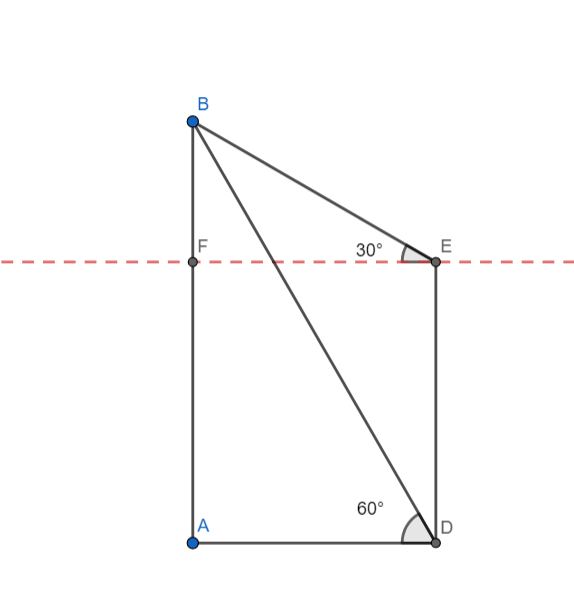Question
Question: The top of a 15m high tower makes an angle of elevation of \(60{}^\circ \) with the bottom of an ele...
The top of a 15m high tower makes an angle of elevation of 60∘ with the bottom of an electric pole and an angle of elevation of 30∘ with the top of the pole. What is the height of the electric pole?
[a] 5m
[b] 8m
[c] 10m
[d] 12m
Solution
Hint: Use the fact that tanθ=Adjacent sideOpposite side. Find tan of angle D in triangle BDA and use the fact that tan60∘=3. Hence find the length of the side AD. Again find tan if angle E in triangle BEF and use the fact that tan30∘=3 and hence find the length of the side BF. Use the fact that ED = AB – BF to determine the height of the tower.
Complete step-by-step answer:

AB is a tower of height 15m. ED is an electric pole at a distance from the tower, The angle of elevation from the top(E) of the pole to the top(B) of the tower is 30∘ , and the angle of elevation of the bottom(D) of the pole to the top(B) of the tower is 60∘.
To find: The height of the pole ED.
In triangle ABD, we have AB is the side opposite to D and AD is the side adjacent to D.
We know that tanθ=Adjacent sideOpposite side
Hence, we have
tanD=ADAB
We know that AB=15,D=60∘
Hence, we have
tan60∘=AD15
We know that tan60∘=3
Hence, we have 3=AD15
Multiplying both sides by AD, we get
3AD=15
Dividing both sides by 3, we get
AD=315=53
Since ADEF is a rectangle, we have AD = EF.
Hence, we have EF=53
Now, in triangle BEF, we have
BF is the side opposite to E, and FE is the side adjacent to E.
We know that tanθ=Adjacent sideOpposite side
Hence, we have
tanE=FEBF
We know that EF=53 and E=30∘
Hence, we have
tan30∘=53BF
We know that tan30∘=31
Hence, we have
31=53BF
Multiplying both sides by 53, we get
BF=5
Now, we know that
BF+FA = AB
Since ADEF is a rectangle, we have AF = ED
Hence, we have
BF+ED = AB
ED + 5 = 15
Subtracting 5 from both sides, we get
ED = 10
Hence the height of the pole is 10m.
Hence option [c] is correct.
Note: Verification:
In triangle BEF, we have
tanE=EFBF=535=31
Hence, we have
tanE=tan30∘⇒E=30∘
Hence the angle of elevation of the top of the tower from the top of the pole is 30∘
In triangle ABD, we have
tanD=ADAB=5315=3⇒D=60∘
Hence the angle of elevation of the top of the tower from the bottom of the pole is 60∘
Hence our answer is verified to be correct.
